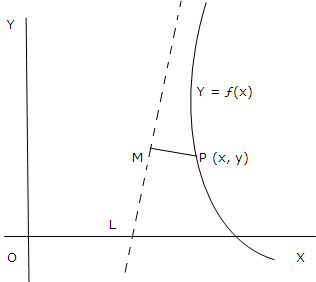Asymptotes:
If a curve is arbitrarily nearer to an infinite segment of a line L, then L is known as an asymptote of the curve. Equivalently, we provide the following:
Definition: The line y = mx + c (m ≠ 0) is called as an asymptote of a curve y = ƒ(x) if the perpendicular distance of any arbitrary point P(x, y) on the curve from the line tends to zero as x -> ∞ + or - ∞.
We shall now calculate the conditions in order that the line
y = mx + c
is an asymptote of the curve y = ƒ(x). If p shows the perpendicular distance of any point P(x, y) on the curve from the line, then

By definition p →0 as x → ± ∞
=> (y - mx - c) = 0 (i)
(y - mx - c) = 0 (i)

Since otherwise the limit in (ii) could be

This calculates the value of m. Now, by (i), we have
c = m  (y - mx) (iv)
(y - mx) (iv)
This calculates the value of c.
Rule: The line y = mx + c (m ≠ 0) is an asymptote of the curve y = ƒ(x), where m and c are calculated by
m  y/x ,c =
y/x ,c = (y - mx).
(y - mx).